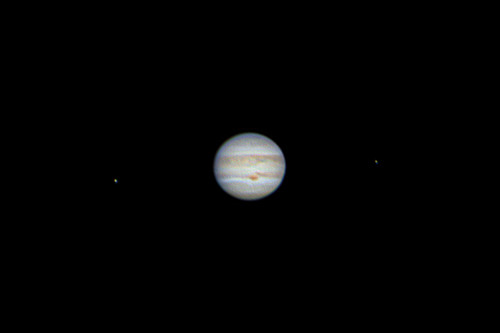21 – 22 August 2020, 21:45 – 01:30
Conditions: Strong, frequent gusts of wind. More cloud than the forecast predicted, particularly early on.
Seeing: Good
Transparency: Average
Given the windy conditions (and the prospect of clouds forcing a premature conclusion) I stuck to one eyepiece (13mm Ethos, 92x) for almost the entire session. As it turned out I got more telescope time than expected, but with another moon cycle already underway and more stormy weather forecast, it’ll probably be the last session for a while.
After beginning with a look at the always-beautiful Albireo, I crossed the border into the constellation of Vulpecula.
NGC 6802, open cluster, Vulpecula
Moderately large hazy patch on the eastern end of Cr 399 (Coathanger cluster/asterism). A handful of stars resolved with averted vision, the brightest pair being near the centre; otherwise grainy. Nice to finally get a decent look at this cluster. The “Coathanger” of course looked better in the finder than it did in the eyepiece.
NGC 6882/6885 (Caldwell 37), open cluster, Vulpecula
Loose, large group of medium-bright and faint stars surrounding a bright blue-white star (20 Vulpeculae). The identification of this cluster (or clusters) is a thorny issue which I’m staying well clear of, other than to say this is a rich star-field, so it’s hard to tell where the boundaries of this cluster (or clusters) are.
NGC 7686, open cluster, Andromeda
Small group of faint stars surrounding a bright orange-yellow star. Again, sits in quite a rich star-field, so an easy cluster to overlook if you’re just sweeping through the area.
NGC 7296, open cluster, Lacerta
Compact little cluster in a rich section of the Milky Way. The stars form an outline vaguely resembling (to my eyes at least) a water lily flower on a lily pad.
NGC 7243 (Caldwell 16), open cluster, Lacerta
Large, rich cluster; on first glance vaguely triangular in shape. Over time it started to take on the outline of a rocket in flight, with a wide pair of bright stars near the base (the engines) and a closer double near the centre.
NGC 7209, open cluster, Lacerta
Large cluster of similarly bright stars. Quite rich but also loose and sprawling, not condensed. The stars seem to be arranged in a meandering trail, like a snake or a winding river.
While I was in the area I hopped over the border into Cygnus to look for the Cocoon Nebula, but couldn’t see anything obvious. At this point (23:00) the wind was getting really gusty, so I redeployed the telescope counterweight to hold down my star chart. Next stop, Pegasus.
NGC 7331 (Caldwell 30), galaxy, Pegasus
Quick look at an old favourite. Appeared as a bright streak of light at 92x.
NGC 7217, galaxy, Pegasus
Bright round galaxy, south of Pi Peg in western Pegasus. Brighter towards the centre, particularly with averted vision.
NGC 7662 (Caldwell 22), Blue Snowball Nebula, planetary nebula, Andromeda
Couldn’t resist a quick look at this one - another old favourite. Exquisite little blue-grey disc with a slightly darker centre. Definitely one to revisit with the DeLite on a less windy night.
I drew a blank on NGC 7640 (galaxy in Andromeda, south of the Blue Snowball), but I had more luck with the next three galaxies.
NGC 7457, galaxy, Pegasus
Small, faint round galaxy, north of Beta Peg (Scheat). Brighter core with averted vision.
NGC 7332, galaxy, Pegasus
Small streak of light (edge-on galaxy?) west of Lambda Peg, aligned roughly north-south. Bright, star-like nucleus with averted vision. Field star off the southern tip.
NGC 7177, galaxy, Pegasus
Small round galaxy in western Pegasus; somewhat faint. Brighter extended core with averted vision (not star-like).
I also looked for galaxy NGC 7448 near the bright blue-white star Alpha Peg (Markab), but again, failed to see this one.
NGC 7479 (Caldwell 44), galaxy, Pegasus
Faint streak of light, bar-like core with averted vision. Field stars either end of long axis. I remember seeing this one before; it has faint spiral arms which should be just about visible in my scope on a better night.
NGC 7814 (Caldwell 43), galaxy, Pegasus
Bright oval haze, a little brighter towards the centre with averted vision.
NGC 7619 & 7626, galaxies, Pegasus
Pair of small round galaxies in same fov, close to the Pegasus/Pisces border. The western one (7619) was a little brighter and larger; 7626 is 7’ to the east. Both galaxies showed star-like cores with averted vision. I didn’t know it at the time, but these are the brightest two members of the Pegasus I Galaxy Cluster, some 250 million light years away.
After drawing a blank on NGC 7741 (galaxy in the square of Pegasus), I relocated to Aquarius.
M72, globular cluster, Aquarius
A little condensed, grainy with averted vision. With time some faint stars became visible on the outskirts of the cluster, including two stars south of the core. Two bright field stars east of the cluster.
NGC 7009 (Caldwell 55), Saturn Nebula, Aquarius
Bright, pale aquamarine ellipse. Quite elongated for a planetary nebula.
At this point (1:30) I was almost ready to pack up for the night, but there was one last target rising from the east which demanded my attention (and a higher magnification).
Mars, 171x (7mm DeLite): The red planet is starting to look very impressive now. Still in its gibbous phase, but the SPC was very bright, and appeared to be surrounded by a dark hood. Syrtis Major was prominent and showed hints of finer detail, including a dark feature that appeared to divide as it extended towards the bright limb of the planet. The Baader Contrast filter didn’t show me anything that wasn’t visible in the unfiltered view, but it made it easier to see, and provided a warmer, more aesthetically pleasing image. Despite the wind and the fact it was still only just clearing the fence, this was definitely the best view I’ve had of Mars to date.
Nature note:
More frogs (at least 11); more bloody mosquitoes.

